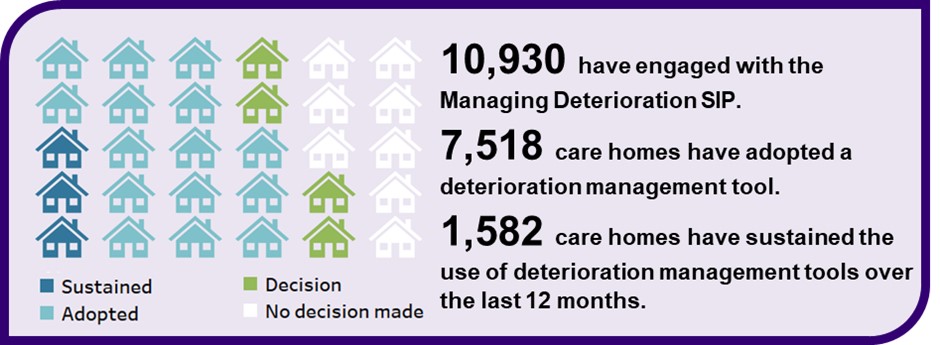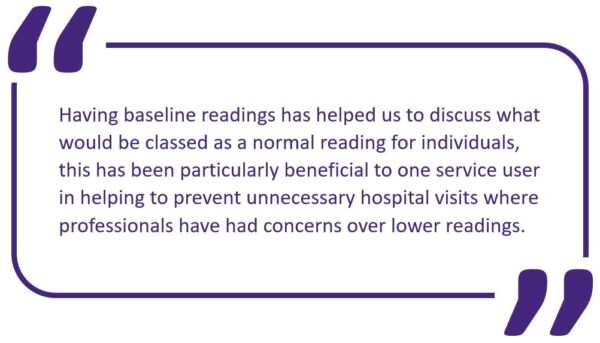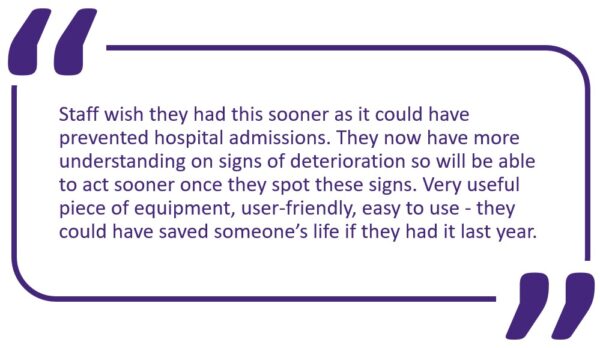Patient Safety Collaboratives (PSCs) have engaged nearly 11,000 care homes over the last two years, in an NHS England commissioned programme designed to help support care homes in managing deterioration. Their role is to support care homes in adopting tools that help staff to identify the early signs of physical deterioration in residents. Over 7,000 care homes have adopted a deterioration management tool during this time, with more than 1,500 using these for over 12 months.

Having worked with care homes for a number of years, PSCs are well-placed to support the National Patient Safety Improvement Programme’s Managing Deterioration in care homes work and have developed a number of resources. In addition, Eastern AHSN and PSC supported a telehealth system pilot.
East Midlands AHSN develops REACTTO training
East Midlands AHSN have supported communities in developing training packages. The REACTTO series provides care home staff with information on how to spot a resident who is becoming unwell and how to escalate appropriately using structured communication tools.
Wessex AHSN develops RESTORE2 tool and training
Wessex AHSN have worked with West Hampshire CCG to develop the RESTORE2 physical deterioration and escalation tool and training for care homes, which has been spread across all 15 PSCs. RESTORE2 has also been adapted to create RESTORE2mini for care homes wanting to use a ‘soft signs’ approach and has versions for care homes, domiciliary care, and learning disability care settings.
In partnership with Health Education England, Wessex AHSN, West of England PSC and and West Hampshire CCG have also developed a number of training videos, which have received over 1 million views to date. Their ‘Managing Deterioration using NEWS’ series contains 15 videos for care home staff and their ‘Carer videos to support those who are unwell’ series has seven videos developed for those caring for people with learning disabilities.
Since its release in 2018, RESTORE2 has won a number of awards, the most recent being the 2020 Health Service Journal (HSJ) ‘Recognising and Responding to Deteriorating in Care and Nursing Homes’ award. In 2021, the RESTORE2mini learning disability project was shortlisted for both the ‘Learning Disabilities Initiative of the Year’ and the ‘Videos to support the training of carers to identify deterioration and communicate concern’ awards for the HSJ Patient Safety Awards.
Eastern AHSN supports digital tool pilot
Funding from an Innovate UK grant, supported by the PSC and Eastern AHSN, enabled a pilot of the Whzan Blue Box telehealth system. The system provides staff with a digital version of existing processes and adopts a soft signs tool that care homes are already familiar with, such as ‘Is my resident well?’ and the SBAR communication tool.
The box includes all the components needed to take a resident’s vital signs and uses Bluetooth technology to reduce the risk of transcription errors. Healthcare data collected is made securely available to clinical decision-makers so that they can validate readings, view images, monitor trends, and support virtual ward rounds and early intervention.
Care home staff noted an improved response from clinical teams when using the telehealth system, and felt empowered to support residents in remaining in their preferred setting.
The pilot took place over a six-month period at 33 residential care homes across seven clinical commissioning groups (CCGs), representing 1,600 beds. A reduction in conveyances to hospital of 73 (15.75%) was observed during the pilot period. Savings of more than £201k were estimated over the six months including ambulance conveyance, emergency department attendance, emergency hospital admission and the cost of empty care home beds (based on an average stay of 8.22 days). Scaling up the scheme from 2.5% to 80% of care homes in the East of England and extending the period to 12 months could see regional savings of over £12 million, with 100% roll out increasing savings to over £16million
Positive feedback from residents and staff
As a result of the spread and adoption of deterioration tools, positive outcomes are being seen for residents and the health and care system, with reduced 999 calls and emergency department admissions. This benefits residents who can be managed in their homes, as well as reducing system pressure. Staff also are feeling more confident and seeing the benefits as the video below explains:
Staff also provided the following feedback: 
 AHSN Network Patient Safety Director Dr Cheryl Crocker said; ‘We are very privileged to work with our colleagues in the care home sector and are proud of the achievements and progress we have made to keep residents safe and well. We are now able to measure success through a number of positive outcomes, including staff satisfaction, early identification of deterioration and the impacts this has on our health and care system.’
AHSN Network Patient Safety Director Dr Cheryl Crocker said; ‘We are very privileged to work with our colleagues in the care home sector and are proud of the achievements and progress we have made to keep residents safe and well. We are now able to measure success through a number of positive outcomes, including staff satisfaction, early identification of deterioration and the impacts this has on our health and care system.’
- Read more about the managing deterioration in care homes safety improvement programme.
- Find out more about PSCs and the AHSN Network’s patient safety plan.

There is a wealth of HealthTech innovators poised to help solve some of the NHS’ greatest challenges, yet getting a product or new technology adopted at scale in the NHS is far from straightforward. In a recent ABHI member’s survey*, procurement was cited as one of the biggest barriers that innovators face, particularly those from [...]

Tellmi is a social enterprise innovation which aims to address the growing demand for mental health services and tackle health inequalities for young people. It is a digital peer support app available launched in 2017 by psychologist Suzi Godson PhD and engineer Kerstyn Comley PhD. Kersytn explains how Tellmi works. Tell us about the innovation. [...]

The NHS is facing record demand for services. According to The Health Foundation, the NHS waiting list for elective treatment in England has almost tripled in size over the last decade to 7.7 million. And latest figures show there were a record 2.35 million attendances at A&E across England in March this year. We know [...]







